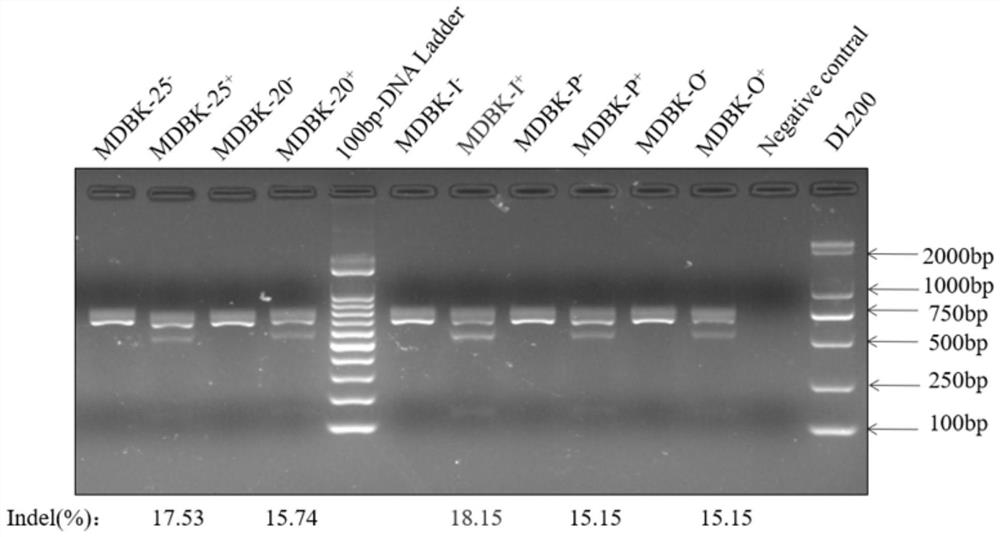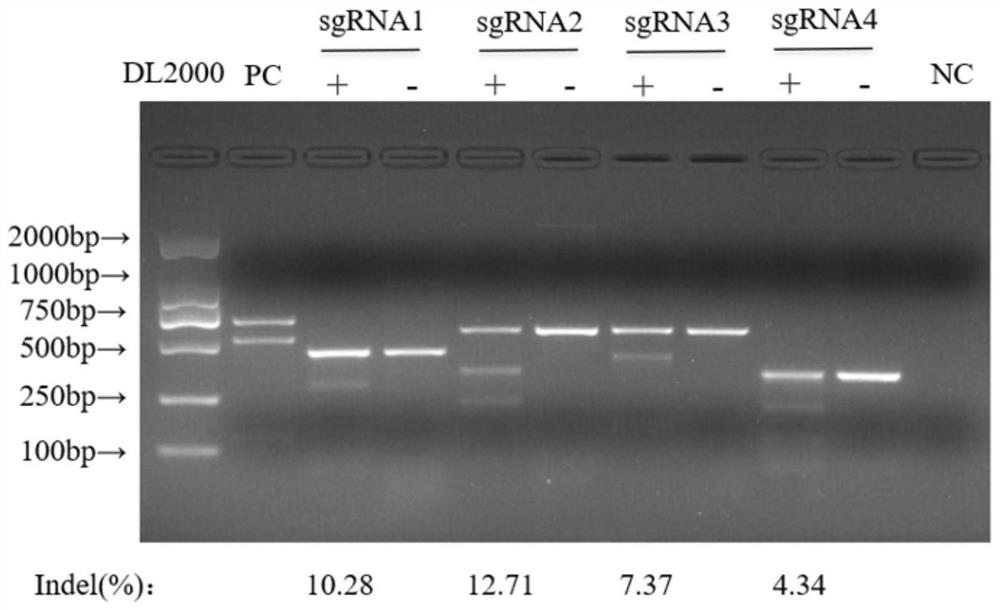Type I interferon receptor gene knockout bovine kidney cell line as well as construction method and application thereof
A technology of gene knockout and construction method, which can be applied in application, genetic engineering, plant genetic improvement and other directions, can solve the problems of slow proliferation and low virus titer, and achieve the effect of high mutation efficiency, low cost, and simple and fast construction method.
- Summary
- Abstract
- Description
- Claims
- Application Information
AI Technical Summary
Problems solved by technology
Method used
Image
Examples
Embodiment 1
[0031]Example 1: Construction of MDBK cells containing Cas9 protein
[0032] The CRISPR / Cas9 gene knockout system is a new generation tool for gene knockout because of its convenient construction and flexible design. The system consists of Cas9 protein with DNA cleavage activity and guide RNA that recognizes specific targets. Since the target recognition can be achieved only by editing the guide RNA in the system, the efficiency of constructing gene knockout vectors is greatly improved. . Among them, the construction of a stable cell line that stably expresses Cas9 protein is a prerequisite for gene knockout. Currently, the commonly used method for constructing a stable cell line of Cas9 protein is as follows: packaging lentivirus expressing Cas9 protein, Cas9 lentivirus infecting target cells, Screening and functional verification of stably transfected cell lines.
[0033] In this experiment, a lentiviral expression vector for Cas9 protein was constructed. Taking advantage ...
Embodiment 2
[0053] Example 2: Construction of IFNAR1 knockout MDBK monoclonal cells
[0054] 1. Resuscitate and subculture the MDBK cells containing Cas9 protein selected in the laboratory in the early stage
[0055] First, the MDBK cells containing Cas9 protein (MDBK-Cas9-I) previously preserved were taken out from liquid nitrogen, and were quickly placed in a 37°C water bath with constant shaking to thaw the cells. Put the thawed cells into a sterile operating table, and use a pipette to suck up 5 mL of cell culture medium (DMEM containing 5% FBS and 2% double antibody), then suck up the cell suspension, pipet repeatedly for several times, and pour it into a centrifuge tube. 1000r / min, centrifuge for 5 minutes, discard the supernatant. Add 2 mL of cell culture medium to a centrifuge tube, pipetting evenly, and then transfer the cells to a six-well plate, set at 37°C, 5% CO 2 Cultured in a constant temperature incubator.
[0056] Subculture was performed when the cells were about 95% ...
Embodiment 3
[0092] Example 3: Validation of monoclonal cell phenotype of IFNAR1 knockout MDBK cells
[0093] Recover wild-type MDBK, and two IFNAR1 knockout MDBK cell lines numbered sgRNA2-10 and sgRNA4-L in T25 cell flasks, and count the cells after they are full, and take 3.5 × 10 cells respectively. 6 3 cells were plated on T25 cell flasks, and the cells were counted after 24 hours of adherence, and then inoculated with BVDV at 0.1 MOI. After the cytopathic effect was complete, the cells were collected, and the wild-type MDBK, sgRNA2-10 and sgRNA4-L cells were measured respectively. Obtained TCID of BVDV 50 , observe the phenotypic differences.
[0094] Repeat the above process, respectively connect IBRV and BPIV-3 to verify whether there is a difference in their phenotypes. The result is as Image 6 It was shown that the viral titers of the IFNAR1-knockout MDBK cell lines numbered sgRNA4-L were significantly increased, regardless of whether it was BVDV, IBRV, or BPIV-3.
PUM
 Login to View More
Login to View More Abstract
Description
Claims
Application Information
 Login to View More
Login to View More - R&D
- Intellectual Property
- Life Sciences
- Materials
- Tech Scout
- Unparalleled Data Quality
- Higher Quality Content
- 60% Fewer Hallucinations
Browse by: Latest US Patents, China's latest patents, Technical Efficacy Thesaurus, Application Domain, Technology Topic, Popular Technical Reports.
© 2025 PatSnap. All rights reserved.Legal|Privacy policy|Modern Slavery Act Transparency Statement|Sitemap|About US| Contact US: help@patsnap.com



